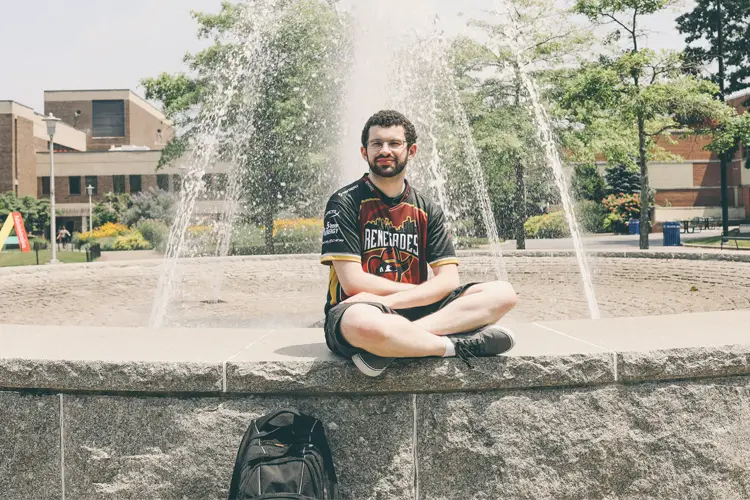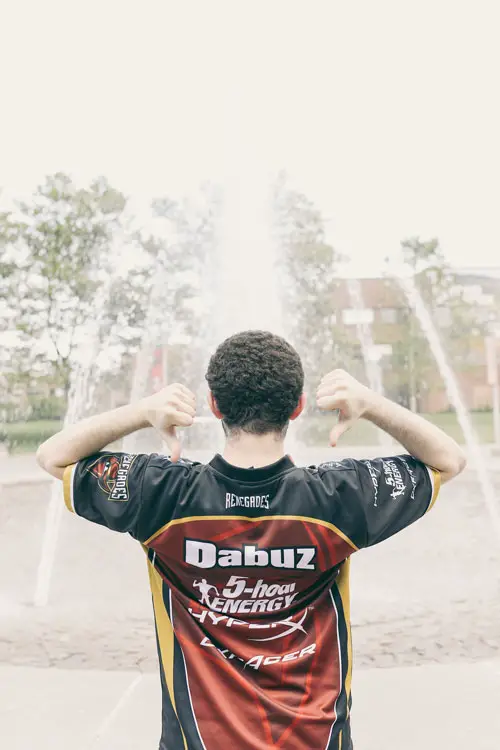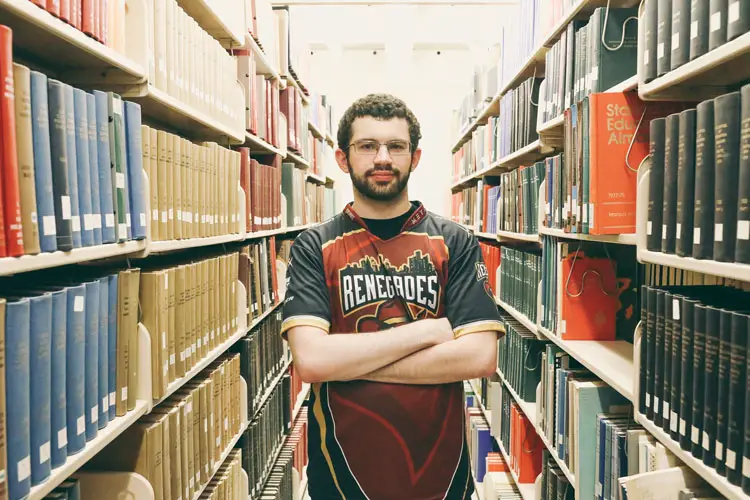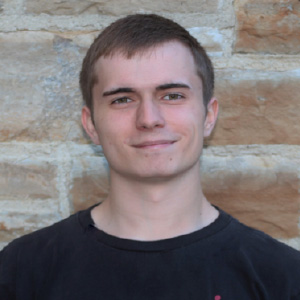Imagine turning the game you loved as a child into a full-time occupation, achieving fame and glory beyond your wildest dreams in an auspiciously developing industry. Imagine being broadcast to thousands of viewers as an inspiration for playing and analyzing a video game that only seems to escalate in appreciation and popularity by the week. Imagine seizing these opportunities to become one of the most highly respected players worldwide, challenging the best to become the best, taking center stage in front of countless fans and even winning a civil war along the way. Now imagine all of these miraculous feats coming to fruition before even graduating college.
That’s exactly what Samuel “Dabuz” Buzby of Stony Brook University has accomplished during his time playing competitive “Super Smash Bros.,” specifically the fledgling Super Smash Bros. for Wii U and 3DS (commonly known as “Smash 4”) in a rapidly evolving eSports industry. Since the game’s release in late 2014, Dabuz, who pioneered the Rosalina and Luma meta game to the level of a top-tier threat, has climbed the competitive ladder to rank as the fourth best player in the world according to the second iteration of the Panda Global Rankings, widely accepted as the primary method of ranking and seeding players.
In addition, he’s universally anticipated to place in the game’s top five once again after version three of the PGR is completed later this month. Easily one of “Smash 4’s” premiere talents and the epitome of consistency, Dabuz is a constant presence in the final top-eight brackets of any given tournament thanks to his iconic analytical nature, stifling opponents with a disciplined style of play that’s perfectly complemented by a nearly unbreakable wall of a character. That killer combination eventually netted Dabuz first place in the biggest tournament to date for “Smash 4,” the much anticipated, upset-heavy 2GGC: Civil War last spring, cementing his legacy as a “Smash 4” champion and household name in the exponentially growing, behemoth eSports industry. Oh yeah, and he’s done it all while balancing and maintaining a full college workload.

Ben Seidel: How did you discover “Smash,” and what led you to wanting to play competitively? Did you have any inspirations or players that you learned from the most?
Samuel Buzby: I started playing “Smash” because my brother had “Smash N64,” and I would play with him growing up, and my friends in middle school played “Melee,” so I played with them casually. I guess my first tournament was at my middle school, there was this “Melee” tournament, a free-for-all with items turned on. I got seventh and I was really angry that I lost. I’ve always had a competitive drive, wanted to be the best at things. I hate losing, and the idea of fighting other people with a similar mindset, plus the ability to make money from the game to buy other video games from playing tournaments, was a good drive for me to want to play the game competitively. “Brawl” was the first game with online, so I figured why not go to the forums on GameFAQs and the “Brawl” online ladder and just practice?
BS: What led you to pick up and eventually main Rosalina and Luma when “Smash Bros. 4” first released?
SB: I just love puppet characters. Some of my favorite games of all time are “Pikmin” and “Starcraft 2”; any game where you control a lot of little minions I like playing, so I played Olimar in “Brawl” and in “Melee” I played a bit of Ice Climbers. Those are my natural characters, so Rosa fit the bill of a minion-based character as well. Also, when I first played her I could feel that she was good. There was a positive initial vibe, just like, “This character works.”
BS: You mentioned your “Brawl” Olimar, but you’ve used Olimar many times in “Smash 4” as well. Do you use him as a secondary because of your previous experience with “Brawl,” or are there a set of characters, or even one specific character, that Rosalina struggles with that you feel he counterpicks effectively against?
SB: Back in the early days of “Smash 4,” when Diddy Kong was completely overpowered, that matchup was impossible for Rosa, and it ended up being that, since I had a “Brawl” Olimar, he transitioned well into “Smash 4.” “Smash 4” Olimar, despite all his perceived weaknesses back then, was a relatively good pick against Diddy. So, I guess I played him because of my history with “Brawl,” but also because he specifically was a good counterpick against Diddy Kong early in the game, and he just kind of stuck.
BS: Would it be fair to call your playstyle defensive? If so, are there any characters, players or situations that you would change that approach against for more aggressive options, or do you prefer to stick with the tried and true?
SB: I like calling my playstyle passive aggressive. My goal is to optimize and perfect every matchup, including every player matchup, so I wouldn’t necessarily say it’s fair to call my playstyle truly defensive or even passive aggressive at all times. I do change my style relative to my opponent and the character they’re playing; sometimes I’ll time my opponent out and sometimes I’ll rush them down. My default style is definitely passive aggressive, but I will change as needed.
BS: What’s your most memorable moment from your “Smash” career thus far?
SB: That’s a difficult one, there are three or four different moments between “Smash 4” and “Brawl” that are very memorable to me. First is when I first played “Smash 4” at a local Best Buy demo prior to the game’s release, once I got to play the game I was completely blown back by it. I’d say the second is when I won the 3DS national tournament, as that was the first big “Smash 4” national tournament. Obviously we were using items and custom moves back then, but still, having all that attention was like, “wow.” Of course Civil War is up there, that’s the biggest “Smash 4” tournament of all time and I won it, so that makes sense.
The fourth might sound like a weird one, but it’s when I truly attained that “Smash understanding” in “Brawl.” I was playing against a player named Envy, an Olimar main in “Brawl” during the early days. We were playing on an online ladder and I lost to him while playing in the Olimar ditto among other characters, and I basically learned how to play Olimar by watching him. A door in my head opened on how to play “Smash” by looking at all the things he was doing with that character and all the mistakes I was making in comparison. Those are my most memorable moments when it comes to “Smash Bros.”

BS: You mentioned your Civil War win, which was such a big tournament for “Smash 4” and a highlight for you in particular, capturing that coveted first place finish after countless top-eight appearances. If you remember, can you tell me what was going through your mind during the final match in Grand Finals against Fatality, as well as your thoughts immediately after winning?
SB: I honestly can’t tell you what was happening in my mind while I was playing Fatality; I was focused on another level. When you’re playing well, sometimes you almost go into this other world in your head where you can’t even think about what’s happening, but at the same time you know everything that’s happening. It’s almost like when you have a dream and upon waking up you forget it…that’s kind of what happened there. I beat Fatality and had my ridiculous pop off, but besides that I can’t remember much about my emotions other than I was just really happy cause I finally did it.
BS: What would you feel is both your greatest asset as a player and something you feel you still need to improve on?
SB: I’ll go with the opposite first; out of all the top players, I actually feel like I’m one of the weakest when it comes to reactions. You’ll see it in my play, I don’t react to things well or I won’t recognize situations fast enough, so I guess speed is one of my weaknesses. But my strength is definitely outside the game, I’m really good at analyzing and breaking down players, matchups and basically anything that requires taking a step back from the game and slowly dissecting it. I think I have every other top player destroyed in this aspect of the game. Except for a few individuals, I don’t think anyone can come close to my abilities to dissect the game and really figure it out on the outside.
BS: Yeah, you have Twitch streams where you analyze matches down to individual frames, right?
SB: Haha, yeah. I have to abuse my best strength, and that’s how you figure the game out. Frame by frame.
BS: What’s your take on the stability and structure of the current “Smash 4” meta game, and where do you think it’s evolving to or trending toward for the foreseeable future?
SB: I think we’ve had a solid top tier for a while now. You know, Mewtwo, Marth, Bayonetta, Sheik etc. I think if you’ll look at any standard tier list you’ll agree with that. I mean, if you look at ZeRo’s tier list…well, I don’t agree with the exact orderings but I agree with the general locations of each character, so that’s pretty stable. The meta’s become very punish-heavy but that’s been the case for a while. I feel like the game hasn’t changed that much in the past year, it’s mainly that people have optimized the strengths of their characters, their punish games and have figured out the neutral game.
I think in the next year you’ll continue to see players further optimizing the game and getting the more difficult combos down, mastering tech chases and getting better at spacing on 50/50 combos. Punish game is where “Smash 4” is leading to until eventually it will be maximized, and after that you’ll see players having better defensive games and good SDI to escape trickier combos, but that won’t be for at least a couple years.
BS: Do you think the lack of recent updates, patches or DLC for “Smash 4” has been the main cause for this stability?
SB: Yeah, definitely. At this point we aren’t expecting more patches, so a person can pick up a character and figure out new techniques without worrying about that character being weakened through a balance patch. Now it’s a lot easier to commit to different play styles and characters. You’ll see that most people don’t pick up secondary characters anymore; back in the patch days, players pick up secondaries every new patch to adapt to a new meta game.
BS: If the fabled “Smash 4” port to the Switch were to become a reality, what new character would you most desire to be added to the roster? If you could add one balance adjustment to the game, what would that be?
SB: First of all, I don’t want any new characters, because DLC characters have always proven to be absolutely busted and poorly designed, so I don’t really want any more. But if I had to have one, I would either pick Shantae from the series of the same title or Isaac from “Golden Sun,” probably leaning more toward Shantae because she attacks by whipping her hair around, which is different as opposed to another sword character, we already have plenty of those.
For balancing, I would nerf Bayonetta and Cloud, mostly Cloud for double’s play. Cloud in double’s is especially bad for the meta game, every team uses him and I feel like a nerf would help the meta so much. It’s not even that he’s unbeatable, but in double’s you almost have to use him, and it’s very discouraging to see the double’s meta slowly dying. People don’t enter as much and teams have become very stagnant just because of one character.
BS: How difficult is it balancing full coursework and a full time professional “Smash 4” career? How do you manage to find time for both college and eSports?
SB: It is very difficult. Generally I’m busy all the time during the school semester, like I’ll have weeks when I’m going to class four days a week, doing homework and taking tests, but that same weekend I’ll fly into a tournament at like 10 p.m. Like for Big House, I flew in an hour before my pools started on Saturday morning. So, I’m constantly doing things like that, and I do have to sacrifice a bit of time for social life stuff to make it all work, but at the same time, I’m able to accomplish a lot of things in college and I have a good amount of money saved up as a result. I do think it’s really stressful though and you do have to sacrifice in your schedule to make it work.
BS: Many colleges encourage traveling through study abroad programs in order to gain a greater scope of the international landscape while understanding other cultures. Based on your experience interacting with players from all over the world, do you feel eSports afford similar learning opportunities?
SB: It depends. I’ve never been on a school-sanctioned international trip, so I don’t know how it compares to what I’ve been doing, but I can say that you do see a ton of different cultures and learn about the world while traveling. If that’s the goal of it, then I’d say it’s similar. At the same time, you don’t get to learn much academic stuff while traveling for “Smash,” whereas for school I’m sure you learn a lot about the country’s history and culture rather than simply being a visitor. So, I guess it’s partially the case, but I do get a lot out of it because I’m doing things I enjoy and learning about how they impact different parts of the world.
BS: What’s the greatest benefit or advantage of “Smash” or eSports as a whole?
SB: Obviously with any competitive game there’s a goal and a drive, so it gives tons of people something to strive for. It’s hard to compare to other extracurricular activities, but I know I always have something I can do or something to practice more. I can go to another tournament or event, or I can stream and there’s always social media stuff I can work on, so there’s always something to do. It’s great experience for all these different paths I can go into with various jobs if I want to do so later. It’s a great outlet for people who are very goal driven, like me.
BS: Colleges around the nation are starting to provide scholarships to eSports teams for team games such as “League of Legends,” but do you see “Smash” growing to the point where collegiate players could be similarly financially compensated for their play?
SB: I actually do think “Smash” is a really great opportunity to get into the real world of business and stuff, so I do feel like colleges could look at it. I mean, you have “Melee” right now. That definitely already happens with “Melee” to a small extent, so it could happen with “Smash 4.” I’ve learned a lot about the business world, so many things with marketing and social media, so much that you wouldn’t get by simply going to classes or doing clubs or that kind of thing. I really think it’s worth school’s investing into for that kind of experience for students.

















